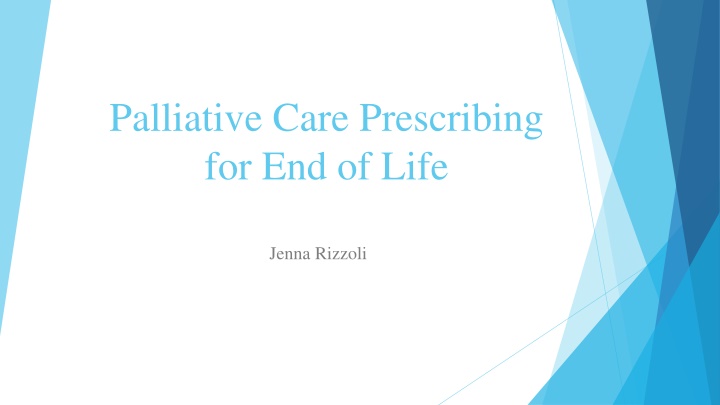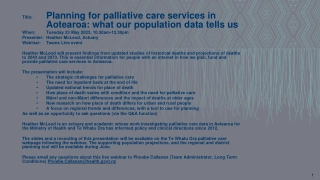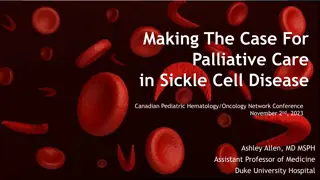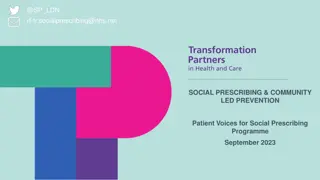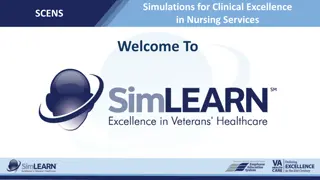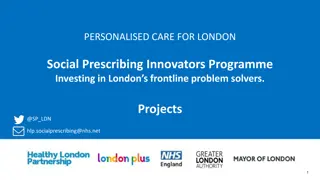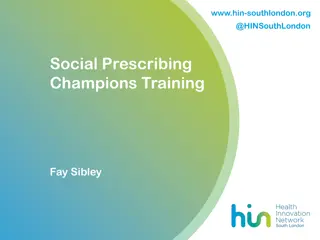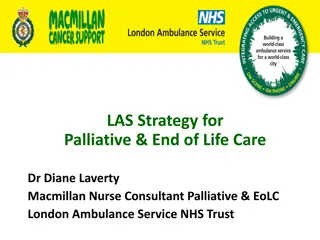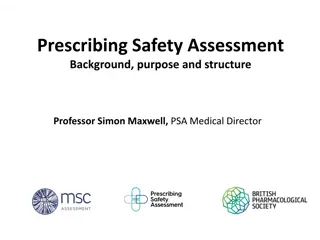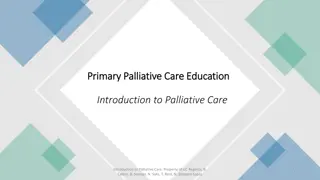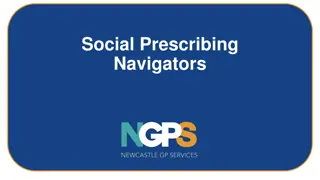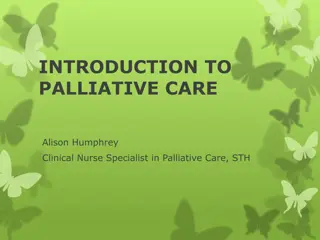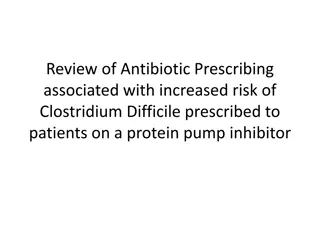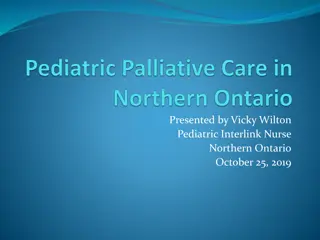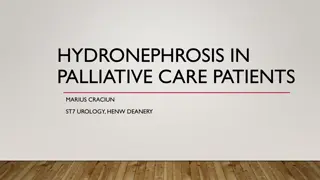Palliative Care Prescribing for End of Life
This study introduces BurstLink techniques for energy-efficient video display in conventional and virtual reality systems. By leveraging display panel local memory to eliminate buffering frames in main memory, BurstLink significantly reduces system energy consumption for planar and VR video streaming. The approach involves directly transferring decoded video frames to the display panel, bypassing the host DRAM, and utilizing burst transfers to exploit maximum display interface bandwidth.
Download Presentation

Please find below an Image/Link to download the presentation.
The content on the website is provided AS IS for your information and personal use only. It may not be sold, licensed, or shared on other websites without obtaining consent from the author.If you encounter any issues during the download, it is possible that the publisher has removed the file from their server.
You are allowed to download the files provided on this website for personal or commercial use, subject to the condition that they are used lawfully. All files are the property of their respective owners.
The content on the website is provided AS IS for your information and personal use only. It may not be sold, licensed, or shared on other websites without obtaining consent from the author.
E N D
Presentation Transcript
Palliative Care Prescribing for End of Life Jenna Rizzoli
Aims Improved Palliative Care Model For Rural and Remote Patients Adequate Symptom Control Reducing Clinical Variations in Practice Improving Quality of Life Working as a multidisciplinary team for the best patient outcomes Continue to closely monitor and review for rapid changes
Palliative Care Telehealth = SPaRTa (Specialist Palliative Care Rural Telehealth) Townville University Hospital s Rural Palliative Care Service Consist of a Palliative Care Consultant, Palliative Care Nurse and Palliative Care Pharmacist Area Catchment = 4 Main HHS, Cairns and Hinterland, Townsville, Mt Isa and Mackay Referrals via Fax or Email to SPaRTa for Rural/Remote patient access Improves Patient Outcomes, Reducing Rural Workload Available for phone advice
Pain Empirical Therapy Morphine Oxycodone (if Morphine contraindicated or if renally impaired) Opioid Na ve Morphine 2.5mg-5mg S/C every 2-4 hours when required Older/Frail patients, use lower end of dosage range (e.g. 2.5mg) If >3 doses required in 24 hours, consider regular opioid therapy Regular + Breakthrough agents Recommend to use same MR and IR medicines (e.g. Oxycodone MR and IR) Breakthrough dose is 1/6thto 1/12thof the past 24 hour opioid requirement Adjustment of regular opioid ONLY if 3 or more breakthrough doses in the past 24 hours.
Pain Clinical Practice Points Changing Opioid Agents. Calculate total past 24 hour dose (excluding anticipated incident pain (e.g. showering). Please note: Important to commence new opioid at 50-75% of calculated equi-analgesic dose. Helpful calculators; eviQ opioid calculator. Transdermal Patch Removal e.g. Buprenorphine (Norspan), Fentanyl (Durogesic). Important to be aware of half-life and pharmacokinetic properties Naloxone Formulations, e.g. Targin (Oxycodone/Naloxone) MR tablets = potential for reduced first pass metabolism.
Agitation and Restlessness Rule out other underlying causative factors: urinary retention, hypoxia Empirical Therapy: 1stLine: Midazolam 2.5mg-5mg S/C every hour when required. Maximum 20mg/24 hours. 2ndLine: Haloperidol 0.5mg-1mg S/C every hour when required. Maximum 5mg/24 hours. (Avoid in Parkinson s disease) 3rdLine: Levomepromazine (SAS, IPA + TGA approvals required; Contact SPaRTa)
Respiratory Tract Secretions Occurs approximately 17-57 hours prior to death. Recommend to prescribe as an anticipatory medicine. Will only reduce production of secretions, not clear what has already been produced. Empirical Therapy Glycopyrrolate (Glycopyrronium): 0.2mg S/C every 2 hours when required, Maximum 1.2mg/24 hours. Hyoscine Butylbromide: 20mg S/C every 2 hours when required, Maximum 120mg/24 hours. May consider ceasing therapy after 24 hours if no improve and unwanted adverse effects. *Please note: This hospital only stocks Hyoscine Butylbromide not Hydrobromide.
Nausea and Vomiting Depends on the underlying cause to which agent is chosen Empirical Therapy Metoclopramide 10mg S/C every 8 hours when required Haloperidol 0.5-1mg S/C every 4 hours when required Levomepromazine (SAS, IPA + TGA approvals required; Contact SPaRTa) Clinical Practice points: Do not prescribe Metoclopramide + Haloperidol concurrently = EPSE QT prolongation E.g. Metoclopramide, Haloperidol, Levomepromazine, Ondansetron. Other medications/Medical conditions E.g. Escitalopram, Atrial Fibrillation Alternative agent = Cyclizine
Dyspnoea Address Underlying Issues. E.g. CCF = Furosemide Empirical Therapy Morphine 2.5mg S/C every 4 hours as required Midazolam S/C every 4 hours as required (Anxiety related) A continuous S/C infusion can be considered if >4 S/C PRNs are required over 24 hours More complex cases, contact Townsville Palliative Care (SPaRTa) Oxygen generally not recommended in last days of life (not hypoxia related) Non-pharmacological strategies, e.g. fans, positioning
Syringe Drivers (NIKI T34) Ensure Drug Compatibilities to avoid precipitation. Contact Pharmacist, SPaRTa or see resources Calculate Opioid Conversion. Contact Pharmacist, SPARTA or see resources Syringe Driver Volumes: 20mL syringe: Total maximum volume = 17mL, runs at 0.7mL/hour 30mL syringe: Total maximum volume = 22mL, runs at 0.9mL/hour Minimum diluent (water for injection or saline) is required for some medicines, particularly in higher concentrations (e.g. Haloperidol 1mg/mL or more) See AIDH resource. Battery Life of Syringe Driver Inpatient: If 15% or less battery life, change battery prior to commencing syringe driver. Outpatient: If 30% or less battery life, change battery prior to commencing syringe driver.
Resources Townsville Palliative Care (Specialist Palliative Care Rural Telehealth - SPARTA: 4433 7423) Therapeutic Guidelines Palliative Care Australian Medicines Handbook Palliative Care Formulary Metro South PallConsult Medicines to Crush Don t Rush to Crush MIMs Australian Injectable Drugs Handbook (AIDH) eviQ Opioid Conversion Calculator Drug Compatibilities The Syringe Driver 4thed. Palliative Care Guidelines Plus Pocketbook of Palliative Care Medicine
References 1. Townsville University Hospital. 2021. End of life Anticipatory Sub/Cut PRN Prescribing Guidelines. 2. Palliative Care Expert Group. Therapeutic guidelines: palliative care. Version 4. Melbourne: Therapeutic Guidelines Limited; 2016. 3. Townsville Hospital and Health Service. 2021. Palliative Care. Retrieved from: https://www.townsville.health.qld.gov.au/services/palliative-care/ [cited 2021 May 17] 4. Australian Medicines Handbook. (2021). Adelaide. Australian Medicines Handbook Pty Ltd. Retrieved from: https://amhonline-amh-net-au.ap1.proxy.openathens.net/ [cited 2021 May 17] 5. Wee, Bee, Hillier, Richard, & Wee, Bee. (2008). Interventions for noisy breathing in patients near to death. Cochrane Library, 2017(4), CD005177 CD005177. https://doi.org/10.1002/14651858.CD005177.pub2 6. MacLeod, R, Macfarlane, S. 2019. The Palliative Care Handbook. 9thEd. Sydney. HammondCare. 7. Queensland Government. 2020. PallConsult. Retrieved from: https://www.caresearch.com.au/EOLCareRACF/Portals/10/Documents/NIKI-pump-practical- handbook-WEB.pdf [cited 2021 May 17]
